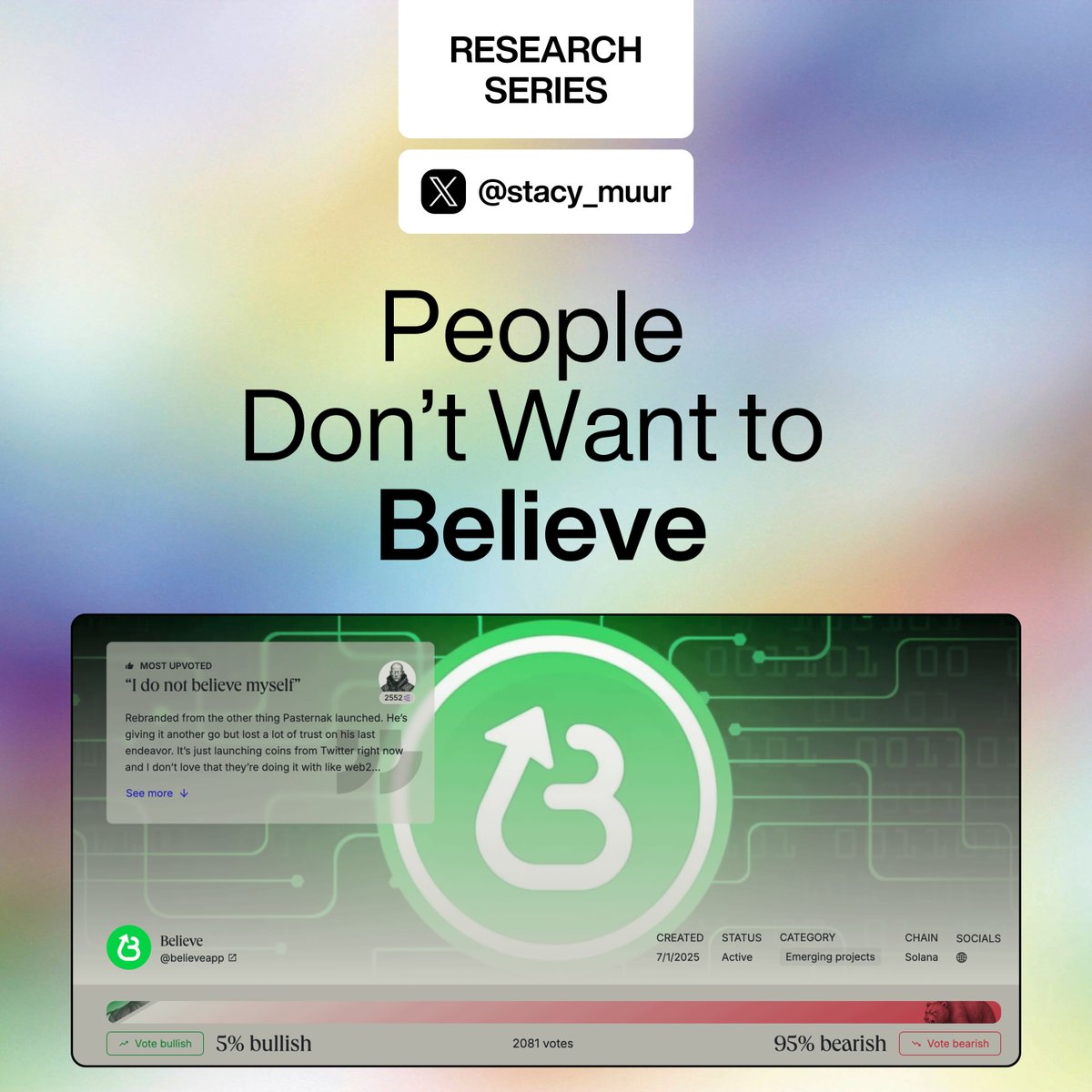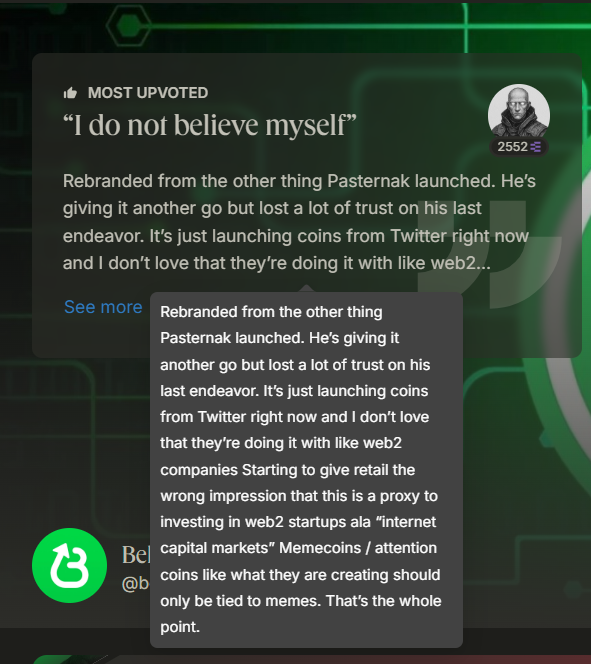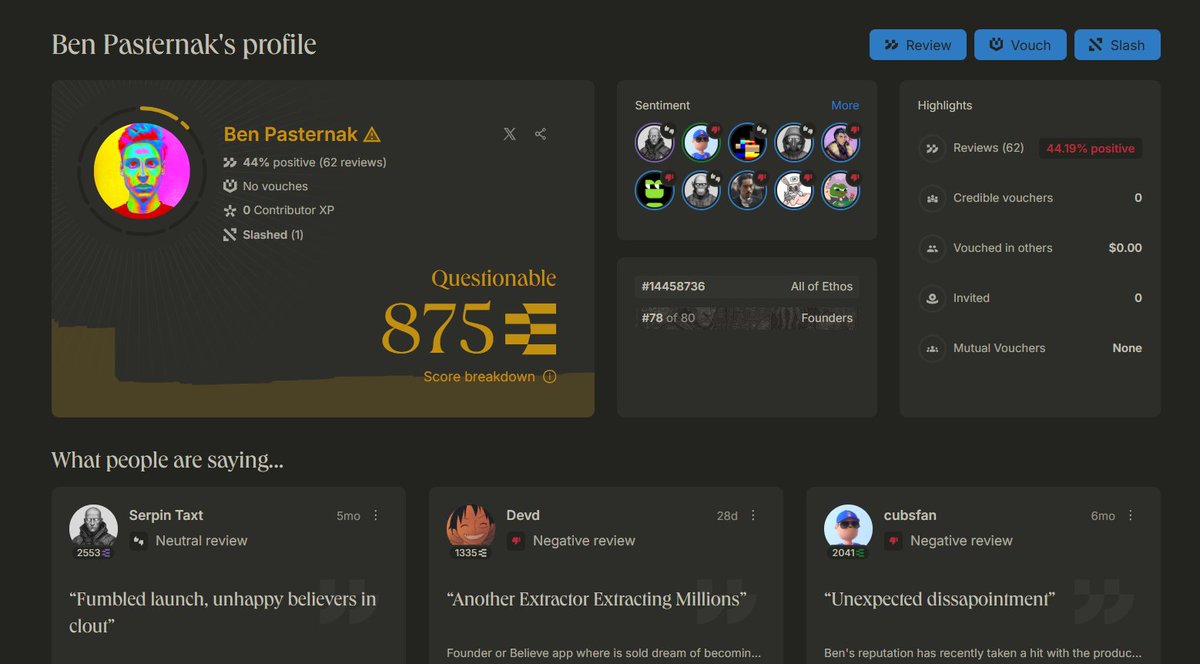Believe says it's building the future of on-chain funding but CT isn’t buying it.
I mapped out the criticism, the receipts, and the deeper problems beneath the surface.
What's wrong with @believeapp?
[RESEARCH SERIES] ↓

For context, Believe is a launchpad built on Solana. Anyone can create a token by replying to a tweet. It rebranded from in 2025 and pitches itself as “Internet Capital Markets.”
Sounds fresh. But what followed triggered heavy backlash.
On Ethos, a platform where users vouch or slash projects by staking ETH, currently Believe is sitting at:
📈 5% bullish
📉 95% bearish
That’s not just a cold start, it’s a massive credibility cliff!

And it’s not just the numbers saying it...
This is the most upvoted review about Believe on Ethos, and the feedback isn’t technical; instead, it calls out a shift:
Believe claims “Internet Capital Markets,” but most of what’s launching looks like memecoins.
It’s about the gap between the pitch and the product.

Memecoins aren’t the issue, framing is. If you call it a funding revolution but most tokens vanish after launch, you’re just accelerating exits.
That’s the gap users are slashing and it’s why sentiment keeps bleeding.
And that sentiment has also been formally challenged. On Ethos, users can also vouch or slash people. Ben Pasternak, founder of Believe, was slashed in a public investigation.
The charge:
Enabling scams, extracting fees, and ignoring the ecosystem he claimed to empower.
Read the full investigation here:

While the slash was driven by a pattern of claims that are hard to ignore, some may sound extreme, yet dozens of users backed them, and the receipts? They’re everywhere.
Ben’s profile on Ethos paints a familiar picture: low trust, no vouches, and a growing list of devs calling out misalignment.
You can explore his full Ethos profile here:

Ben finally broke silence. He admits to mishandling transparency, calls the experience “painful.”
He says they “weren’t prepared,” and promises a flywheel that’ll “set the gold standard.”
But even in this reset, the focus is infra, not access, not trust, not users.
I've been doing a bad job recently with regard to transparency, public trust, and community alignment. That’s on me. It’s been greatly requested that we provide more transparency related to our pending flywheel (FW).
When Believe’s volume surged in May, I didn’t even know what a flywheel was. Honestly, we simply weren’t prepared to be one of the leading platforms in the space.
I had to move fast and surround myself with people who had experience launching similar mechanisms at scale. Believe is now working with a team widely regarded as the best in the space for this kind of work (we’re intentionally not naming them here).
To launch a flywheel in a compliant way, a specific corporate structure is required. Setting up that structure involves several prerequisites that are being expedited as much as possible. We’re now in the final innings of the process.
If I knew what I know now, candidly we would have waited to launch a coin, so that we could have a FW from Day 1.
I know that this has been a painfully long experience for our community and that we’ve been very poor on communication. I apologize for that. The lack of communication has damaged the trust that people have placed in us. It is on us to earn your trust back, and it will take time to do so.
Once our flywheel is live, I believe it will set the gold standard for what’s expected from crypto projects. Every project with a live coin should have an attached flywheel—it’s the obvious future.
Thanks to all for the input so far. We’re still so early.
But alignment issues go beyond access. When founders launch without skin in the game; no token lockups, no roadmap, it breeds extraction and not conviction.
Some say Belief is optimized for viral launches. But capital formation? That part still feels like an afterthought.
These design concerns weren’t just hypothetical. They also started showing up in founder decisions; who stayed, who left, and why....
Then came the moment critics had warned about: breakout projects walking away.
And then came one of the most talked-about departures: @useKled
KLED was not only the most talked about departures but also the project that critics and observers keep circling back to. Because it was not just another token, it was a data monetization protocol with real-world utility, a standout on Believe.
And when KLED left, it wasn’t just a project leaving, it was a stress test for the platform’s promise.
$KLED leaving/left Believe App is an interesting move.
1. Beginning to look like the AI war for the best talent between Open AI, META etc.
2. Did a little checking around some time ago, some traders deliberately avoiding Believe App projects like a plague. Valuations are shot across the board.
3. Any ecosystem you choose to build on would end up being almost the same. Fees and incentives might vary, so you have to make that tough choice.
4. What will make investors continue buying your coin depends on the success of your project and positive token price trajectory.
5. End of day, you just need to pick the ecosystem you have the best relationship with; so that they will support you more over time. Everything else is what you make of it.
6. At least for now, Launchcoin is probably going lower. Don't see much of a risk for projects launched on the platform though. Current buyers are already ones who ignore current negative sentiments of the Believe eco.
7. As more projects leave, the number of fishes in the aquarium will be smaller, so it's definitely going to be easier for Believe (if they wish), to support these projects more whole-heartedly.
8. Long run, won't be surprised that $PUMP actually acquires Believe App. PUMP for memes, Believe for Utility.
This accumulating pattern of criticisms and breakdowns in trust raises a bigger question:
Was Believe ever meant to form capital around ideas?
Or was it always designed to extract attention first, and value later?
Because when meme mechanics replace real project support, builders stop believing too.
But not everyone sees the exits or criticism as a sign of failure. Some are still holding faith and see it as growing pains.
One perspective argues that, Believe fumbled early, poor communication, ignored builders, weak support but has since shifted. That it’s playing the long game, even if it lost some trust along the way.
Been getting asked about migrating $WOM away from @believeapp lately, especially after seeing other founders make the jump 🤔
Honestly? I get the frustration with Ben, but I'm not convinced the grass is greener elsewhere.
I'll be real - my relationship with Ben started rocky as hell. Took days to get his attention, felt completely ignored at the start despite WOM doing numbers. I was frustrated as anyone.
But here's what changed my perspective: watching founders leaving Believe because they wanted more support, then going solo or jumping to other ecosystems where they'll get... even less support? That math doesn't add up to me. Surely its good for the short term PA but down the road? I'm not so sure.
Take Bonk for example. Everyone's hyped about it, and yeah it's fun, price goes up and all, but I have friends who launched utility projects there. None one of them got the support they hoped they would. One of them has one of the most interesting utilities on Bonk and they still can't get through to Tom or BonkGuy, despite having mutual connections and trying HARD.
Meanwhile, after that rocky start, I'm now in regular contact with Ben. His lack of communication early on definitely hurt Believe more than anything - which is crazy considering they had way bigger problems like snipers and hacked launches. But he's turned that around completely.
@pasternak has definitely done plenty wrong, no argument there. But at least he's taking real risks and genuinely thinking long-term about the ecosystem.
If he just wanted quick wins, he could easily load up wallets and pump random tokens. He could easily pump $KLED and make it what Useless is for BONK - the greatest believe ad. And that's what Avi was pushing him to do.
But to be completely honest, I'm glad he chose not to, for a handful of reasons. Sure it hurts a little short term, but Ben's playing the long game and I fully respect that.
It's not about loyalty - it's about what actually works for getting things built.
For utility projects like $WOM, I think we're still in the best spot. The wise move isn't always the popular move 🤷♂️

There’s always one crowd exiting and another quietly doubling down. And amid the noise and exit chatter, some are still zooming out. Not on what’s failing but on what could compound if it works.
let's talk.
don’t believe everything you read about @believeapp.
there’s cognitive dissonance around it, sure from some valid frustrations, but also just dumb FUD.
believe will not slow down
no one will FUD the team or their backers out of a generational opportunity to dominate this space.
working behind the scenes i have realised this:
the best founders (and sometimes products) always win.
- momentum tilts toward greatness.
- believe ecosystem is stacking a level of greatness that cannot be replicated:
we’re talking one-of-a-kind, 10x builders.
(sure, other types too - some will mature into major leaders)
the best traders are agnostic. a good trade is a good trade.
turn notifs on. set up your believe bots.
track tweets, stay close to the flow. the good stuff moves fast.
the best opportunities go beyond trading:
believe is a talent magnet and a networking growth hack.
a lot of very sharp & HNWI ppl are quietly lurking in the ecosystem.
they back quality. they’re bullish on @pasternak and the believe team.
some are benevolent whales or "informal VCs"
they ape early, double down on real founders.
they’re behind some of the strongest projects launched on believe.
it’s a good idea to become a friendly whale to an overlooked gem.
see a good team?
join their “marketing department.” work for your bags. help them win.
beyond potential financial upside, you’ll meet great people.
your web3 network will improve. maybe even your life.
because there are phenomenal humans in the believe & ICM orbit.
the more value you add to good founders, the better it gets.
opportunities will find you.
and you’ll start building the kind of generational wealth you’ve been trenching for.
be a degen sure... but hedge... believe in something too.
So is @believeapp the price of building in public or a pattern repeating?
Not all criticism is truth and not all loyalty is insight. It is hard to tell if this is a witch hunt or a wake-up call. Maybe both can be true because when expectations outrun delivery, even early believers start asking sharper questions.
Belief isn't dead but it's clearly in trust rehab. Not because of one bad launch or some harsh tweets but because public funding promises a public standard and when the standard slips, people slash, not just doubt.
That’s not hate, that’s accountability!
8.66K
85
The content on this page is provided by third parties. Unless otherwise stated, OKX TR is not the author of the cited article(s) and does not claim any copyright in the materials. The content is provided for informational purposes only and does not represent the views of OKX TR. It is not intended to be an endorsement of any kind and should not be considered investment advice or a solicitation to buy or sell digital assets. To the extent generative AI is utilized to provide summaries or other information, such AI generated content may be inaccurate or inconsistent. Please read the linked article for more details and information. OKX TR is not responsible for content hosted on third party sites. Digital asset holdings, including stablecoins and NFTs, involve a high degree of risk and can fluctuate greatly. You should carefully consider whether trading or holding digital assets is suitable for you in light of your financial condition.






